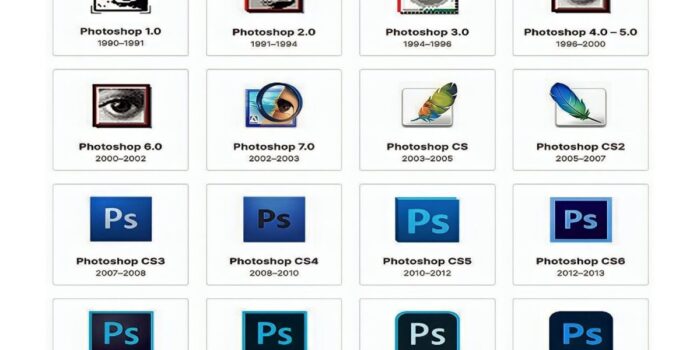In an age where digital distractions seem to multiply by the minute, Opera has launched…

From Image Adjustments to AI: Photoshop Through the Years

Today
Remember when Merriam-Webster added Photoshop to the dictionary back in 2008? Want to learn how AI is changing design forever? Join us as we delve into the history of Photoshop, from its early beginnings right through to the dawn of artificial intelligence.

Photoshop is nothing short of a cultural icon these days. The era-defining software has transcended the status of a simple image-processing platform to become firmly lodged in the public psyche. Tell someone you just Photoshopped a picture, and you can almost guarantee they’ll know exactly what you’re referring to—even if they’ve never tried the platform for themselves.
But where did Photoshop begin? And, more importantly, where is it now?
In this article, we’re going to delve into the history of Photoshop. Join us as we travel through time to discover how a simple image editing tool transformed into a global phenomenon. We’ll discuss the arrival of Adobe, explore the significance of the layers tool, and reveal how Photoshop’s foray into Generative AI is changing the world of design.
But before we get into all that, we must return to the beginning. Let’s journey back to 1987.

Back in 1987, brothers John and Thomas Knoll began working on a program that could display grayscale images on a monochrome Apple Pro Plus computer.
When the brothers realized the software’s potential, both took a break from their backgrounds as image processing experts (who would’ve guessed?) to pursue the opportunity further.
Following a year of development, Thomas and John enthusiastically unveiled the first Photoshop prototype—or ‘ImagePro’, as it was then known. The platform offered a limited number of processes that could apply simple effects to images, such as cropping, resizing, and brightness adjustments.
It goes without saying that this early prototype was a shadow of the platform we use today. But, in the late 80s, this was a big deal. No competitor had come close to the level of sophistication that ImagePro offered. Now, they simply needed to find a way to release the product. Enter Adobe.
1988: The arrival of Adobe

After a brief stint partnering with scanner company Barneyscan, John and Thomas eventually attracted the attention of Adobe Art Director Russel Brown. This was a hard-fought battle. Many publishers had turned their noses up at the opportunity over the last year (if only they knew). Fortunately, Brown saw potential. Adobe agreed to a partnership, and Photoshop was born.
At some point during this fruitful business exchange, ImagePro underwent a significant rebranding, shedding its nascent skin to become the Photoshop platform we all know and love. How this happened is shrouded in mystery, but most unanimously agree it was most likely a boardroom suggestion that stuck.
You might imagine that John and Thomas partnering with Adobe was their golden ticket to sit back and relax, but that couldn’t be further from the truth. The platform was still in its early stages, riddled with bugs, and nowhere near polished enough to release to the public. An official Photoshop 1.0 release was the next step. Now, the real work began.
1990: Version 1.0 – Every platform has to start somewhere

After over a year of development and countless hours of code, Photoshop 1.0 launched to the public on Mac in February 1990. Incidentally, this was also the first time Thomas and John’s idea launched under the Adobe trademark.

Dozens of new features had been incorporated into the platform since the ImagePro days just three years prior, including the familiar Lasso, Magic Wand, Blur, and Gradient tools.
Despite the obligatory bugs, Photoshop did relatively well upon release. Adobe mass-marketed the software as a platform that anyone could benefit from, helping to change the narrative that image editing software was exclusive to creative professionals.
While the initial offering was rather primitive compared to what we’re used to today, Photoshop 1.0 laid a rock-solid foundation for the years ahead.
1991-3: Version 2.0 and 2.5 – Expanding Features

With the development of Photoshop version 2.0 well underway, Adobe expanded its team, bringing in engineer Mark Hamburg to assist Thomas Knoll with coding.
The unveiling of 2.0 introduced exciting new features, such as the Pen tool, CMYK color model, and widely popular Paths feature.
Version 2.5 took a further two years to release. If you’re wondering why a seemingly minor release took such a long time, it’s because 2.5 involved rewriting all of the platform’s code for Windows. Photoshop had, until now, been a Mac-exclusive release, but the platform’s growing success meant it was the perfect time to dive into the growing Windows market. Along with this version came a dedicated toolbar for filters and 16-bit file support.
1994: Version 3.0 – Adobe Adds a New Layer to its Offering

At this point, Photoshop was beginning to establish itself as a revolutionary program. Now, it needed to cement its place as the king of innovation. Fortunately, Version 3.0 did just that.
It was in 1994 that Thomas Knoll developed what would become one of Photoshop’s most iconic and well-loved features. Of course, we’re talking about Layers.
Suddenly, users could edit separate images in the same project, combining ideas to create cohesive graphics. If there was one feature that catapulted Photoshop to mainstream success, this is the one.
1996: Version 4.0 – Minor Adjustments

Following the monumental Layers upgrade in version 3.0, it may come as no surprise that the rest of the millennium was a period of relative quiet for Photoshop.
Despite this, there were still some significant improvements during the period. Version 4.0 brought with it two more core features of modern-day Photoshop: Adjustment Layers and Actions.
1998-9: Version 5.0 and 5.5 – Quiet Progress

Photoshop 5.0 arrived in 1998, adding Editable Type and the option to undo multiple times (making the software considerably less agonizing following an unfortunate mistake). This update also brought Color Management and the Magnetic Lasso tool.
Adobe unveiled Version 5.5 just a year later, adding Extract and Save for Web functions to make it easier for anyone looking to create web graphics.
2000: Version 6.0 – New Millennium, New Tools

With the turn of the millennium came Photoshop 6.0, bringing with it Text Warp, the Liquify Filter, and the ability to create Vector Shapes.
At this point in our history, you may be surprised at just how many of Photoshop’s staple features were invented over twenty years ago. Who knew the Layer tool came into existence in the 90s? Time really does fly.
2001: Adobe Photoshop Elements – The Competition Hots Up

This is the first time in Photoshop’s history that Adobe decided to rethink its strategy.
By 2001, everyone was jumping on the Photoshop bandwagon. The competition was beginning to catch up, and Adobe realized the growing number of features offered by the platform might lead new consumers to choose less complex alternatives.
To combat this, Adobe introduced Photoshop Elements, a stripped-down, cheaper version of the platform designed to give beginner users all of the essentials without overwhelming them with the intricacies.
Elements was successful, so much so that Adobe still releases the product today.
2002: Version 7.0 – More Stability means Fewer Crashes

With Photoshop Elements out into the world, Adobe was free to turn its attention to what it does best—making new features.
Version 7.0 introduced fully-vectorized text, a new file system, the Patch Tool, and the Healing Brush. Numerous optimizations were also provided to Mac OS X users who had previously reported crashes while in the middle of a project.
2003: Creative Suite – A New Dawn of Photoshop

The launch of Adobe Creative Suite (CS) in 2003 combined Photoshop with several other Adobe programs such as Illustrator, InDesign, Acrobat, and the recently unveiled Premiere Pro. The new suite also brought with it a number of requested Photoshop features, including larger file support, bigger canvases, and the Match Color tool.
Incidentally, the launch of CS also introduced Photoshop’s Counterfeit Deterrence System, which could recognize images of money and prevent users from printing duplicate banknotes. Checkmate, forgers!
2005: Creative Suite 2 – Features Galore

By 2005, Photoshop had firmly cemented itself as the jewel in Adobe’s crown. But, as with any market leader, competition was becoming increasingly stark. Dozens of rivals were promising Photoshop’s capabilities without the hefty price tag. To stay at the top, Adobe needed to keep pushing the boundaries. How did they accomplish this, you ask?
Did somebody say more features?

Photoshop CS2 arrived in 2005. Users could now select multiple layers at once. Vanishing Point allowed for innovative perspective editing. The Red Eye Removal tool made it easier than ever to fix photo flaws. If Photoshop Elements was brilliant for beginners, CS2 was rapidly becoming a playground for professionals.
2007: Creative Suite 3 – Adapting for the Smartphone

Photoshop CS3, unveiled in 2007, aimed for optimization over groundbreaking features. The update bolstered support for Windows Vista and embraced Macintosh Intel processors, leading to quicker load times and improved performance. The most significant addition in CS3 was the addition of graphic optimization for mobiles, owing in part to the rise in popularity of a rather unusual device known only as the ‘smartphone’. Oh, if only we knew.
2008: Creative Suite 4 – “Photoshop” Becomes a Verb

By 2008, Photoshop was firmly lodged in the public zeitgeist. The platform had long been the world’s premier image editing app, but now it had transcended the ordinary—so much so that all images thought to be edited were now referred to as being ‘Photoshopped’. Even Merriam-Webster got involved, including Photoshop as a verb in the dictionary for the first time.
But, never content to rest on its laurels, Adobe continued to push forward with new ideas.
Photoshop CS4 arrived in 2008. The update was widely hailed for its instantaneous panning and zooming features. This version also introduced auto-blending, auto-alignment, and tabbed documents for multitasking.
2010: Creative Suite 5 – Adobe still has more features to add?

In April 2010, Adobe Photoshop CS5 arrived, bringing with it Content-aware Fill, Bristle Tips, Puppet Warp, and the Mixer Brush. Plus, the optimized Camera RAW compatibility and improved video support meant even photographers had reason to celebrate in this update.
2012: Creative Suite 6 – A Fresh UI Breathes New Life

Creative Suite 6 rolled out in 2012. The new update redesigned Photoshop’s UI, making the interface darker to reduce eye strain and make it easier to focus on what really mattered—that being the design itself.

CS6 was widely hailed for the unveiling of a highly-requested background save feature. Previously, designers had no choice but to save their work regularly in case of an unwanted crash or shutdown. Now, Photoshop did the all-important job automatically with periodic autosaves. We’re sure many forgetful designers breathed a massive sigh of relief.
2013: Creative Cloud (CC) – The Arrival of Subscription Pricing

The introduction of Photoshop Creative Cloud (CC) marked another significant milestone in Adobe’s history, primarily due to the introduction of a subscription-only pricing model. Understandably, this change was met with mixed reviews.

This update also introduced several new tools, including the Smart Sharpen, Intelligent Upsampling, and Camera Shake Reduction features. Finally, as Photoshop was transitioning to a cloud model, users could now also sync their preferences and designs across multiple devices.
2014: Photoshop CC 2014 – Small but Significant Changes

CC 2014 brought significant improvements to content-aware tools and new innovative blur filters such as Spin Blur and Path Blur. This update also focused heavily on optimization, adding several new features to decrease task processing times.
2015: Photoshop CC 2015 – An Anniversary to Remember

CC 2015 marked Photoshop’s 25th anniversary. To celebrate the momentous occasion, Adobe unveiled Adobe Stock, a giant library of stock photos designed to make it easier for designers to find relevant images for their work. Accompanying this improvement were minor UI changes and gestures for touch devices.
2016: Photoshop CC 2017 – Minor Tweaks and Improvements

CC 2017 brought some small quality-of-life improvements to the table, offering a new search function and template sector. It was around this time that Adobe also began to provide support for SVG OpenType fonts. Designers, rejoice!
2017: Photoshop CC 2018 – An Old Feature Gets a Makeover

CC 2018 delivered a monumental overhaul to the much-loved brush tool, introducing over 1,000 new brush styles designed by Kyle T. Webster.
In addition, the update included the addition of the Select Subject, and Eraser tools.
2018-9: Photoshop CC 2019 – Minor Tweaks

CC 2019 introduced the Frame Tool, an easier way to create placeholder frames for images. Other notable additions included Live Blending Mode previews and the Transform tool.
2019-20: Photoshop 2020 – Photoshop Gets an App

Photoshop 2020 dropped in November 2019, bringing a bundle of improvements. It introduced a slick object selection tool, enhanced transform warp, and a new properties panel, making complex selections and edits feel smoother. Notably, Photoshop also landed on the iPad with this update, offering cloud document syncing across devices.
2020-21: Photoshop 2021 – Everything’s Better with a Friend

Photoshop 2021 enabled users to work together via the cloud. Users could invite collaborators and sync presets quickly to build shared creative spaces.
This update also delivered dozens of new tools, such as Sky Replacement, Skin Smoothing, Neutral Filters and Live Shapes.
2021-2: Photoshop 2022 – Small and Steady Upgrades

The arrival of Photoshop 2022 introduced a new Depth Blur Neutral Filter, the ability to mask several objects simultaneously and complete XDR support.
At this point in our history, you may notice that Adobe’s updates were becoming more frequent but less significant. Photoshop was already incredibly feature-rich. By 2022, it felt more like a case of fine-tuning rather than introducing game-changing tools.
Little did we know—Adobe had one more ace tucked away up its sleeve.
2022-3: Photoshop 2023 – The Arrival of Artificial Intelligence

Whether you love it or loathe it, there’s no denying Photoshop’s most recent update will likely stand as its most significant. Never in the history of the software has one tool impacted the way creatives use the platform in such a monumental fashion.
Have you guessed what it is yet? Of course, we’re talking about AI.
In May 2023, Adobe unveiled a Photoshop beta like no other. Leveraging its new Firefly AI technology, the company introduced a whole host of features based on machine learning.
The new Generative Expand tool allows users to resize any image of their choosing using text prompts.

Once the user is happy with their selection, they can generate their content, and Adobe’s tool will fill the space automatically, creating a new image that blends seamlessly with the original.

Of course, no Photoshop AI discussion is complete without talking about Generative Fill. This incredible feature allows designers to add, remove, and replace elements within images simply by selecting a region and utilizing text prompts.

Whether it’s adding mountains to a backdrop, or, indeed, placing a classic car in an inhospitable landscape, Generative Fill makes creativity an instantaneous process.
Firefly AI has opened up a world of creative possibilities for designers. It’s saving users time, assisting with complex tasks, and making graphic design more accessible for everyone.
But, naturally, that doesn’t mean Photoshop’s new update is without its controversies. Generative AI is exciting and intriguing, for sure. But it’s also scary.
Many designers are apprehensive about the feature, torn between using AI to speed up their workflow and sticking to their creative roots. After all, creatives make a living from their knowledge and expertise. Does AI devalue that? Some believe so.

Others are concerned that the development of AI for Photoshop will contribute to the homogenization of the industry. In other words, as more and more designers make AI a core aspect of their workflows, complacency will become the norm, and creatives will stop attempting to push boundaries.
But, regardless of the debate, it’s almost irrefutable that Photoshop 2023 will go down as the most influential Adobe update of all time.
What’s next for the platform? The answer will be determined by the trajectory of machine learning. As AI develops, Adobe will continue to push the boundaries of image editing. And, if we’ve learned anything over the course of the company’s history, they’re showing little sign of slowing down.
Summing Up
From simple cropping and image adjustments to layers and cloud support, Photoshop has been on a long and winding road over the last three-and-a-half decades. With twenty-four versions, over a dozen logo changes, and a rich history of updates, Adobe’s magnum opus has cemented itself as the one true king of image editing platforms.
And yet, despite the platform’s rich history, Generative AI will likely enter the records as the most significant Photoshop update ever.
But will Firefly AI be remembered for its positive impact or its negative consequences? In the following decades, will we be praising machine learning for revolutionizing creativity or lamenting it for destroying a profession that was, until now, uniquely human? Time will surely tell.
What are your thoughts on Photoshop’s AI revolution? Do you like the new Photoshop, or do you miss the good old days? Tweet at us and let us know your thoughts.
Max Walton
Born in Cardiff Wales, Max relocated to Brisbane when he was 12. He’s spent the last five years developing expertise in the Fintech industry. When he’s not posting about Web3, you’ll find him on a paddleboard.
#Image #Adjustments #Photoshop #Years


